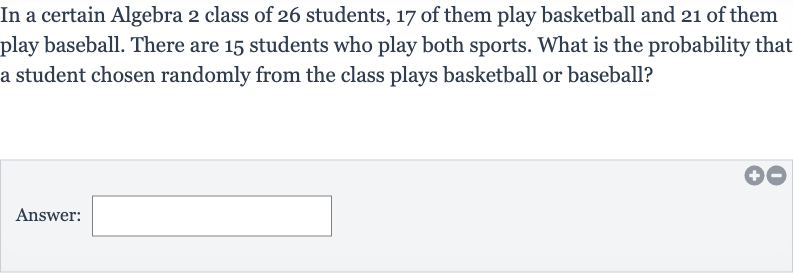AI tutor
Welcome to Bytelearn!
Let’s check out your problem:

In a certain Algebra class of students, of them play basketball and of them play baseball. There are students who play both sports. What is the probability that a student chosen randomly from the class plays basketball or baseball?Answer:
Full solution
Q. In a certain Algebra class of students, of them play basketball and of them play baseball. There are students who play both sports. What is the probability that a student chosen randomly from the class plays basketball or baseball?Answer:
- Principle of Inclusion-Exclusion: To find the probability that a student chosen randomly from the class plays basketball or baseball, we need to use the principle of inclusion-exclusion. This principle states that for any two sets, the size of their union is the size of the first set plus the size of the second set minus the size of their intersection.
- Given Information: First, let's identify the given information:- Total number of students in the class: - Number of students who play basketball: - Number of students who play baseball: - Number of students who play both sports:
- Calculate Students Playing Either Sport: Using the principle of inclusion-exclusion, we calculate the number of students who play either basketball or baseball (or both) as follows:Number of students who play basketball or baseball Number of students who play basketball Number of students who play baseball Number of students who play both sports
- Plug in Numbers: Now, let's plug in the numbers:Number of students who play basketball or baseball =
- Perform Calculation: Perform the calculation:Number of students who play basketball or baseball =
- Continue Calculation: Continue the calculation:Number of students who play basketball or baseball =
- Calculate Probability: To find the probability, we divide the number of students who play basketball or baseball by the total number of students in the class:Probability =
- Express Probability: Now, let's calculate the probability: Probability =
- Express Probability: Now, let's calculate the probability:Probability = To express the probability in simplest form, we can leave it as a fraction or convert it to a decimal:Probability =
More problems from Probability of simple events
QuestionGet tutor help
QuestionGet tutor help
QuestionGet tutor help
QuestionGet tutor help
QuestionGet tutor help
QuestionGet tutor help
QuestionGet tutor help
QuestionGet tutor help
QuestionGet tutor help
